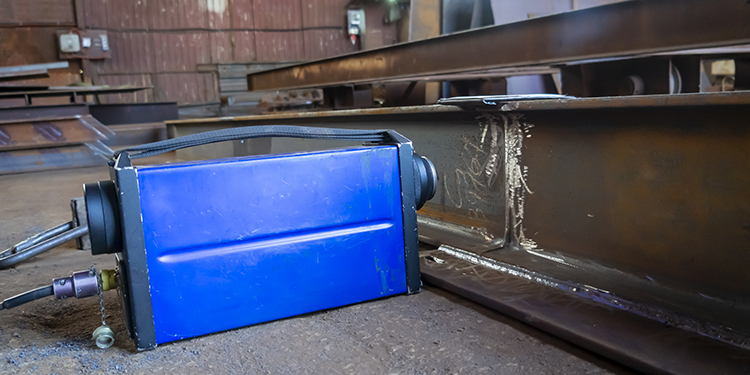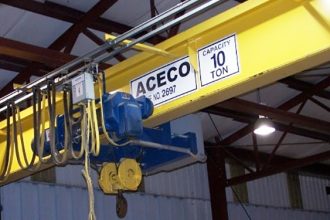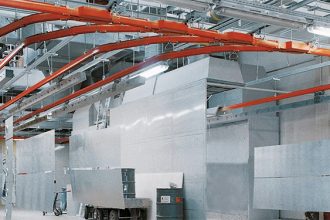
To ensure both the safety and the optimal functionality of both patented track and enclosed track monorails, it is critical to inspect a variety of system components and operating functions at specific intervals. The Monorail Manufacturers Association (MMA) of MHI recommends four different types of monorail inspections: Initial, Pre-Shift, Frequent, and Periodic. Additionally, inspections should align with the safety recommendations in ANSI MH27.1: Patented Track Underhung Cranes and Monorail Systems, ANSI MH27.2: Enclosed Track Underhung Cranes and Monorail Systems, and OSHA 1910.179, the Standard for Industrial Overhead and Gantry Cranes.
Here, an overview of what each type of inspection should include, how frequently they should occur, and what components should be examined during each assessment.
Initial Inspection: This occurs after a new monorail has been installed or an existing monorail has been modified or repaired. An initial inspection verifies that the monorail is in working order prior to commissioning to ensure that all safety and operational functions perform as intended. These inspections are performed by the original equipment manufacturer (OEM), and look at items such as clearances, operating speeds, lubrication levels, control settings, safety devices, and more.
They also include a rated load test performed after the underhung trolley and lifting device are installed on the supporting structures, including I-beams. Per OSHA, “test loads must not be more than 125% of the manufacturer’s rated load unless otherwise recommended by the manufacturer. The resulting load rating for the hoist must not be more than 80% of the maximum load sustained during the test.” Documentation of the inspection is provided to the monorail’s owner to keep on file for the life of the equipment. Additionally, if the monorail was repaired, modified or altered, an initial inspection report documenting the affected areas should also be kept on file.
Pre-Shift Inspection: Sometimes called a daily inspection or a pre-operational check, these visual and operational assessments are conducted at the start of each shift by the monorail operator. For guidance, MMA offers two Daily Checklists: MH27.1 for patented track systems and MH27.2 for enclosed track systems.
These inspections include a variety of items, including confirming that the monorail has not been tagged with an out-of-order sign; that all motions align with control device markings; that there is no excessive drift in deceleration; that all bolts are installed and tight; that no cracks or defects are visible in welds; that end stop assemblies are properly installed; that the capacity of the hoist and trolley do not exceed the capacity of the system; and that there are no unusual sounds detected. These inspections may or may not be documented on paper or electronically, although more operations are requiring their monorail operators to document that the assessment has been performed.
Frequent Inspection: The scheduling of frequent inspections depends on multiple factors, including how often the monorail is used across how many shifts, the operating conditions, and the types of loads handled and their average weight (duty cycles). MH27.1 and MH27.2 identify three different duty service classes: infrequent/light (with inspections required semi-annually to semi-monthly), frequent/heavy (with inspections required monthly to weekly), and continuous/severe (with inspections required weekly to daily). Additionally, OSHA 1910.179(j)(1)(ii)(a) requires periodic inspections to be conducted on daily to monthly intervals.
These inspections can be performed by a trained in-house employee or by an outside expert (either the OEM or a third-party inspection firm). All the same elements are examined as in a pre-shift inspection, but in more detail. All items should be recorded as inspected with the report kept on file for three years. Specifically, the inspection of the trolleys and hoists — including their hooks, wire ropes, and load chains — must be documented with a certification record that includes the date, signature of the inspector, and serial number (or identifier) of each component. Any safety hazards should immediately be reported to the monorail owner.
Periodic Inspection: Highly detailed and exceedingly thorough, these inspections occur at a minimum of annually, as well as semi-annually, or quarterly depending on the monorail’s frequency of use, handled load characteristics, and operating environment. Additionally, OSHA 1910.179(j)(1)(ii)(b) requires periodic inspections to be conducted from 1- to 12-month intervals. These evaluations are typically performed by an OEM or third-party inspection firm. They include all the items assessed in pre-shift and frequent inspections, as well as a comprehensive examination of structural, electrical, and mechanical components. Inspection for wear, cracks, or other damage is performed on brakes, shafts, axles, wheels, couplings, sheaves and drums, transmission components, tracks, trolleys, and below-the-hook devices.
A sticker is typically affixed to the system to verify that the periodic inspection has occurred and to document the date it was performed. Further, a written report is issued that is to be kept on file both by the monorail owner and the company that performed the inspection. These reports document all findings and identify safety hazards, maintenance issues, and code or standard violations, as well as make recommendations for corrective actions. If a repair is warranted, the owner may elect to request a second opinion (particularly if the repair is costly) and may choose whom they wish to perform the work.
In addition to identifying areas in need of service, the previous documentation collected from each of these four types of assessments is typically referred to by the inspector as a means to both pinpoint areas for additional review and determine trends in wear or usage. This information can be used to better develop a strategic maintenance and service plan to help prolong the life of the equipment and improve total cost of ownership.
Want to learn more ways monorails can help your workers be both safer and more productive? The members of the Monorail Manufacturers Association (MMA) are the industry’s leading suppliers of monorails and workstation crane systems. The group offers a variety of resources—including a product certification program, recommended practices for workstation cranes and patented track systems, and more—via its website at www.MHI.org/MMA.



